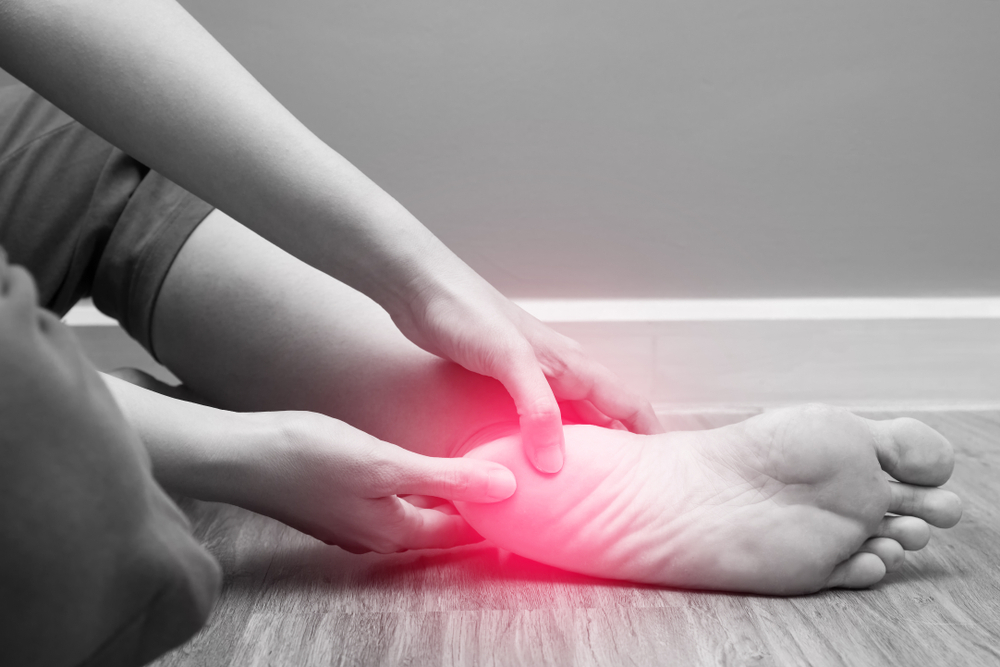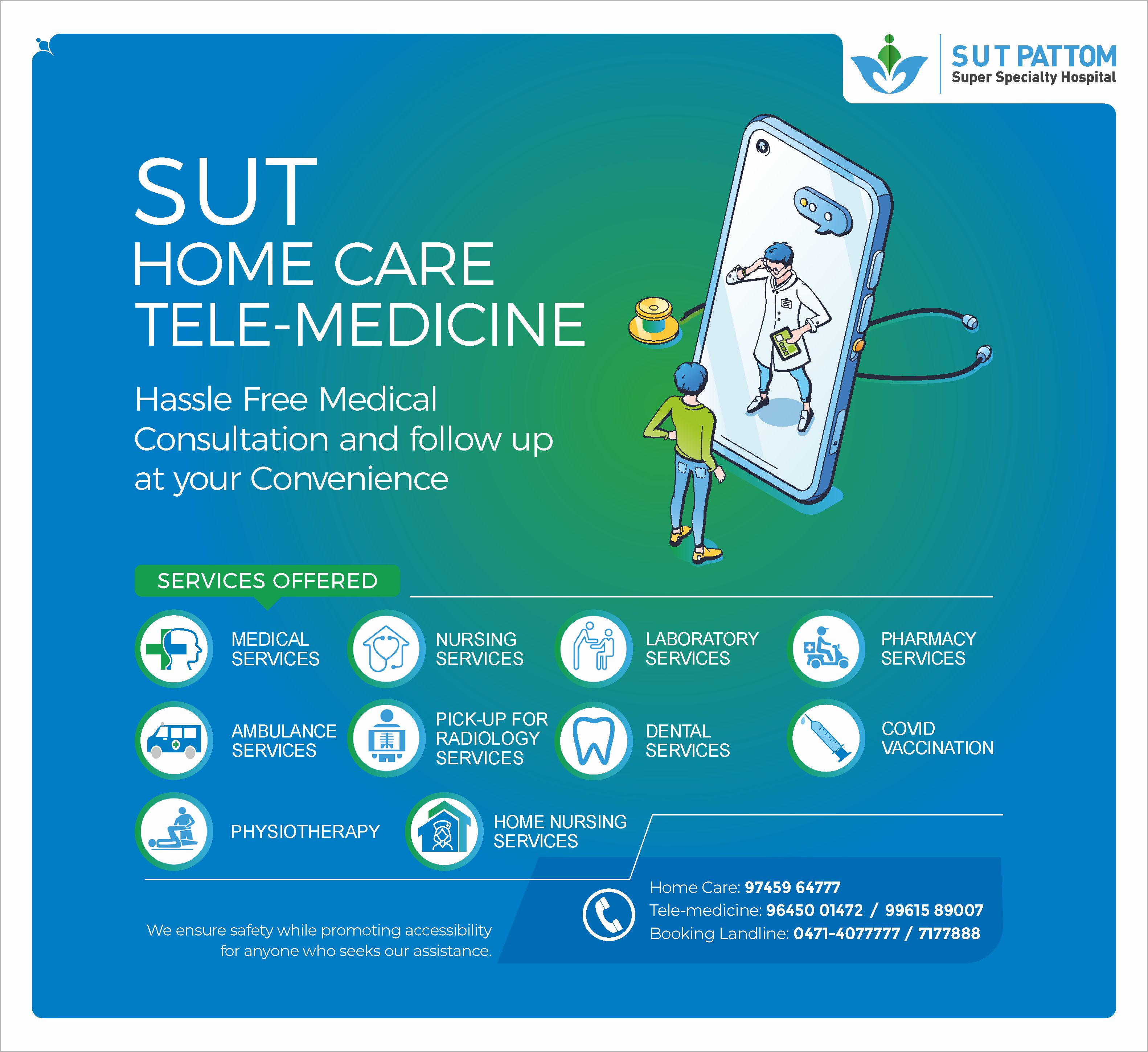- Emergency Ambulance Services
- 8606811111
- 0471-4077777, 0471-7177888
- gro@sutpattom.com
Best Diabetic Foot Clinic Trivandrum
SUT Pattom brings to you “FOOT CARE AT YOUR SERVICE” with the best team of Plastic Surgeons specialised in Podiatric Surgery and Physicians specialised in diabetology, dedicated to treat, save and protect YOUR FEET FROM FURTHER HARM. These doctors are experts in their respective fields with many years of experience. Foot ulcers affect 25% of diabetic people in their lifetime. 85% of amputations are preceded by foot ulcers. Most foot injuries and infections occur during the monsoons.
> What increases the risk of developing foot ulcers?
– If you have reduced sensation to your feet. The risk of these occurring increases the longer you have diabetes and the older you are.
– If your diabetes is poorly controlled. This is one of the reasons why it is very important to keep your blood sugar (glucose) level as near normal as possible.
– If you have narrowed blood vessels (arteries). The risk also increases if you have any other risk factors for developing the furring of the arteries. For example, if you smoke, do little physical activity, have a high cholesterol level, high blood pressure (hypertension) or are overweight.
– If you have had a foot ulcer in the past.
– If you have other complications of diabetes, such as kidney or eye problems.
– If your feet are more prone to minor cuts, grazes, corns or calluses which can occur.
– If you have foot problems such as bunions which put pressure on points on the feet.
– If your shoes do not fit properly, which can put pressure on your feet.
If you have leg problems which affect the way that you walk or prevent you from bending to care for your feet.
> Are foot ulcers serious?
Although foot ulcers can be serious, they usually respond well to treatment. However, foot ulcers can become worse and can take a long time to heal if you have diabetes, particularly if your circulation is not so good. In addition, having diabetes means you are more likely to have infections and infection in the ulcer can occur. Occasionally, more serious problems can develop, such as tissue death (gangrene).
> What can I do to help prevent foot ulcers?
# Have your feet regularly examined
Most people with diabetes are reviewed at least once a year by a podiatric surgeon (Foot Specialist – Qualified in identifying and treating foot disorders) and other health professionals. Part of this review is to examine the feet to look for problems such as reduced sensation or poor circulation. If any problems are detected, then more frequent foot examinations will usually be recommended.
# Treatment of diabetes and other health risk factors
As a rule, the better the control of your diabetes, the less likely you are to develop complications such as foot ulcers. Also, where appropriate, treatment of high blood pressure (hypertension), high cholesterol level, and reducing any other risk factors will reduce your risk of diabetic complications. In particular, if you smoke, you are strongly advised to stop smoking.
# Footcare
Research has shown that people with diabetes who take good care of their feet and protect their feet from injury are much less likely to develop foot ulcers.
Good foot care includes
– Looking carefully at your feet each day, including between the toes. If you cannot do this yourself, you should ask someone else to do it for you or use a mirror. Looking is particularly important if you have reduced sensation in your feet, as you may not notice anything wrong at first until you look.
– If you see anything new (such as a cut, bruise, blister, redness, or bleeding) and don’t know what to do, see a podiatric surgeon. Do not try to deal with corns, calluses, verrucas, or other foot problems by yourself. In particular, do not use chemicals or acid plasters to remove corns etc.
– Use a moisturizing oil or cream for dry skin to prevent cracking. However, you should not apply it between the toes, as this can cause the skin to become too moist which can lead to an infection developing.
– Look out for fungal infection. It causes flaky skin and cracks between the toes, which can be sore and can become infected. If you have athlete’s foot, it should be treated with an anti-fungal cream.
– Cut your nails by following the shape of the end of your toe. But, do not cut down the sides of the nails, or cut them too short, or use anything sharp to clean down the sides of the nails. These things may cause damage or lead the nail to develop an ingrown nail. If you cannot see properly do not try to cut your nails, as you may cut your skin. You should ask someone else to do it.
– Wash your feet regularly and dry them carefully, especially between the toes
– Do not walk barefoot, even at home. You might tread on something and damage your skin.
– Always wear socks with shoes or other footwear. However, don’t wear socks that are too tight around the ankle, as they may affect your circulation.
– Shoes, trainers and other footwear should
* Fit well to take into account any awkward shapes or deformities (such as bunions).
* Have broad fronts with plenty of room for the toes.
* Have low heels to avoid pressure on the toes
* Have good laces, buckles or Velcro fastening to prevent movement and rubbing of feet.
* When you buy shoes, wear the type of socks that you usually wear. Avoid slip-on shoes, shoes with pointed toes, sandals, and flip-flops. Break-in new shoes gradually.
– Always feel inside footwear before you put footwear on (to check for stones, rough edges, etc).
– If your feet are an abnormal shape, or if you have bunions or other foot problems, you may need specially fitted shoes to stop your feet rubbing.
Tips to avoid foot burns include: checking the bath temperature with your hand before stepping in; not using hot water bottles, electric blankets, or foot spas; not sitting too close to fires.
What if I develop a foot ulcer?
– You should tell your doctor podiatrist straight away if you suspect an ulcer has formed. Treatment aims to dress and protect the ulcer, to prevent or treat any infection, and also to help your skin to heal.
– The ulcer is usually covered with a protective dressing.
– A nurse or podiatrist will normally examine, clean and redress the ulcer regularly
– A podiatrist may need to remove any hard skin that prevents the ulcer from healing. Also, depending on the site and size of the ulcer, they may protect it from further injury by using padding to take the pressure off the area
– You may also be advised to wear special shoes or have a cast made for your foot to keep the pressure off the ulcer.
– Antibiotics will be advised if the ulcer or nearby tissue becomes infected
– Sometimes a small operation is needed to drain pus and clear dead tissue if the infection becomes more severe.
In some cases, the arteries in the legs are very narrow and greatly reduce the blood flow to the feet. In these cases, an operation to bypass or widen the arteries may be advised. Many foot ulcers will heal with the above measures. However, they can take a long time to heal. In some cases, the ulcer worsens, becomes badly infected, and does not heal. Sometimes the infection spreads to nearby bones or joints, which can be difficult to clear, even with a long course of antibiotics. Occasionally, the tissue in parts of the foot cannot survive and the only solution then is to surgically remove (amputate) the affected part.
What care can I expect if I am admitted to the hospital with a diabetic foot problem?
– If you have a diabetic foot problem, you will be able to get most of the treatment you need from your GP or other health professionals working in the community. However, there are some problems which may require you to go into hospital for treatment
– You should expect to be treated by a team that deals especially with people who have diabetic foot problems.
– You should be given information about your foot condition.
– You will have your diabetes assessed and checks will be made to make sure you have not developed complications such as kidney disease (or if you have already developed complications, to make sure they are not becoming any worse)
– If you have an ulcer, this will be checked for infection; baseline measurements of the size and depth will be taken.
– You will have a general examination to make sure you do not have a high temperature (fever) or any other signs of a severe generalized infection.
– You will have an examination of both feet to check for ulcers, cuts, and abrasions to the feet, signs of poor circulation, areas of numbness, and the development of Charcot’s arthropathy. This is a condition in which the sensation of pain is reduced because of diabetes, resulting in damage to bones, such as tiny fractures.
– You may be asked to have an X-ray or scan of your foot to make sure the bones have not been affected by your condition.
Our Team in SUT Pattom
+ Leading and Senior Diabetologists to control your sugars
+ Plastic Surgeon specializing in diabetic foot problems wound care and soft tissue reconstruction
+ Vascular surgeon for bypassing blocked vessels to improve blood supply
+ Cardiologist for opening up blocked vessels by peripheral angioplasty
+ Orthopedicians for foot and ankle reconstruction
+ Radiologist to for vascular assessment
+ General Physician to take care of your other medical health problems
+ Pedortho tists (Footwear Specialist)(coming soon)
Our facilities in foot lab
– VPT to assess the degree of nerve damage (neuropathy)
– ABI and Vascular Doppler to assess blood supply
– Pedopodograph to assess high-risk areas for ulcers
– TcpO2 for assessment of microangiopathy(coming soon)
– Cath lab for revascularization procedures
– Diabetic footwear (coming soon)
– Neurostim(to treat neuropathic pain refractory to medication)(coming soon )
SUT pattom is known for the best podiatric surgery in Kerala. With the vision of doctors and surgeons, with modern medical equipment and the best treatment practices is the right choice for putting your feet first.
Foot injuries and Foot infections are health issues that require immediate attention because they can lead to foot ulcers which precede 85% of amputations. The Diabetic Foot Clinic of SUT Pattom, which is the best Diabetic Foot Clinic in Trivandrum, offers patients the finest Diabetic Foot Treatment. The team of Diabetic Foot Specialist in SUT Pattom, Trivandrum assists diabetic patients to identify the risk factors at the earliest. Also, the Diabetic Blister treatment at SUT Pattom Trivandrum saves and protects their feet from further complications.
Foot ulcers can be prevented by examining the feet regularly, especially if any symptoms have been detected. The Diabetic Foot Clinic of SUT Pattom, which is the best Diabetic Foot Clinic in Trivandrum assists patients to identify the risk factors at the earliest by offering the finest Diabetic Foot Treatment. The team of Diabetic Foot Specialist in Trivandrum examines diabetic patients at least once a year and, any problems detected, more frequent foot examinations are recommended. Also, the Diabetic Blister treatment at SUT Pattom Trivandrum saves and protects their feet from further complications.
Reduced sensation to feet, poorly controlled diabetes, narrowed blood vessels and more, increases the risk of developing foot ulcers. The Diabetic Foot Clinic of SUT Pattom, which is the best Diabetic Foot Clinic in Trivandrum, offers patients the finest Diabetic Foot Treatment. The team of Diabetic Foot Specialist in Trivandrum assists patients to identify the risk factors at the earliest and offer proper treatment. Also, the Diabetic Blister treatment at SUT Pattom Trivandrum saves and protects their feet from further complications.






